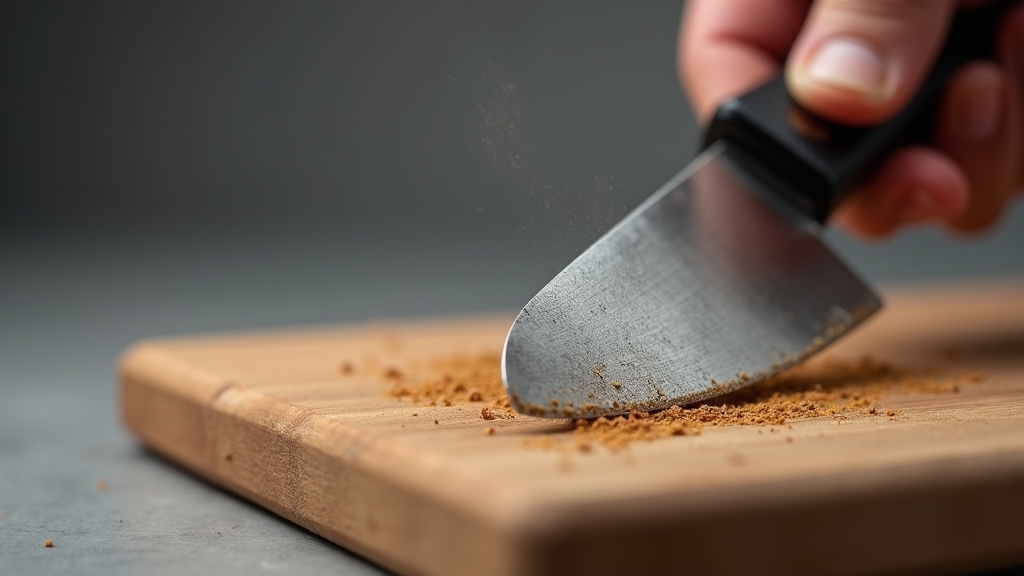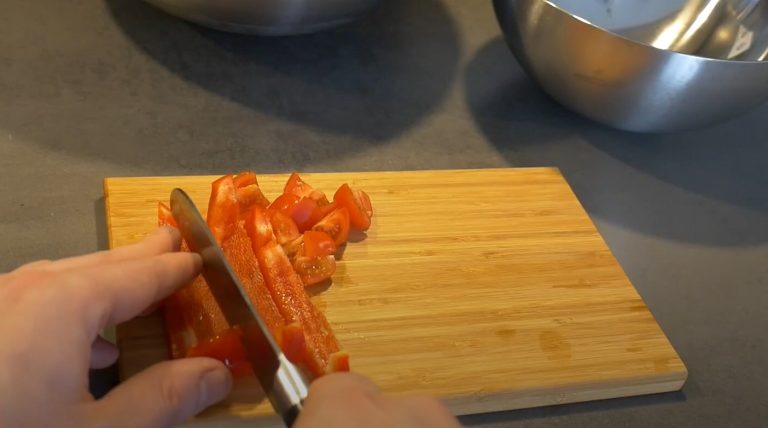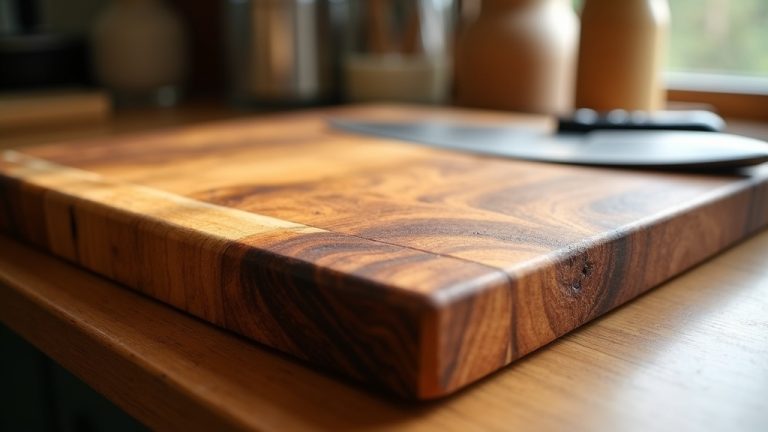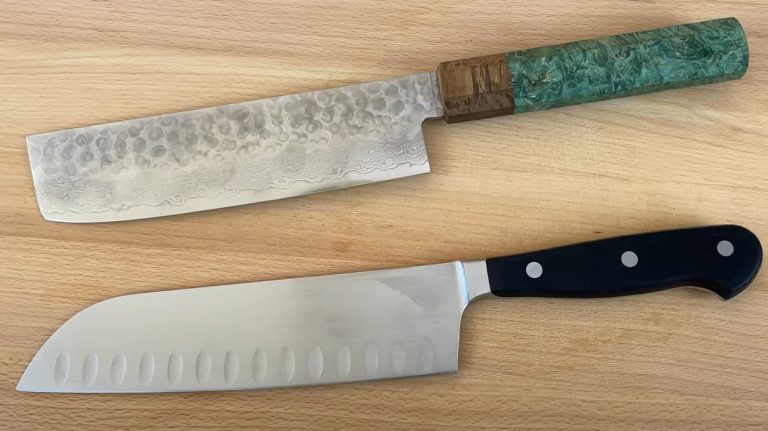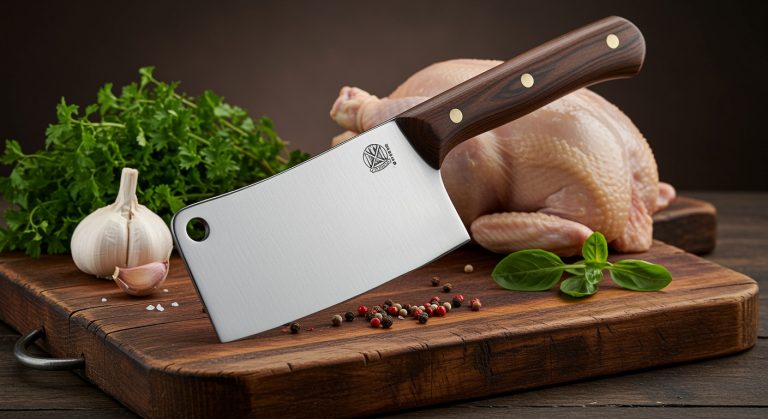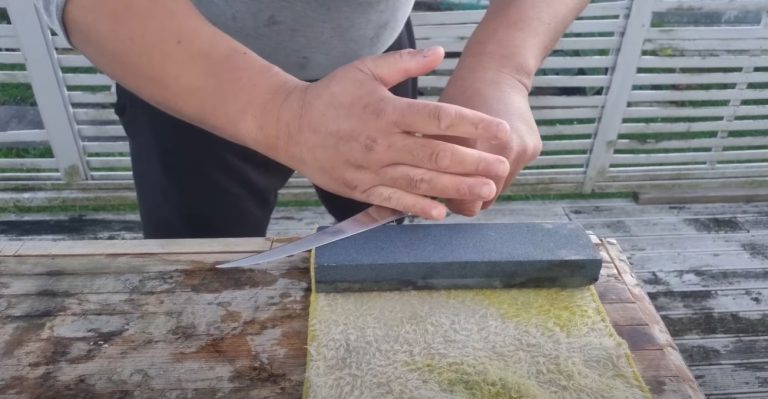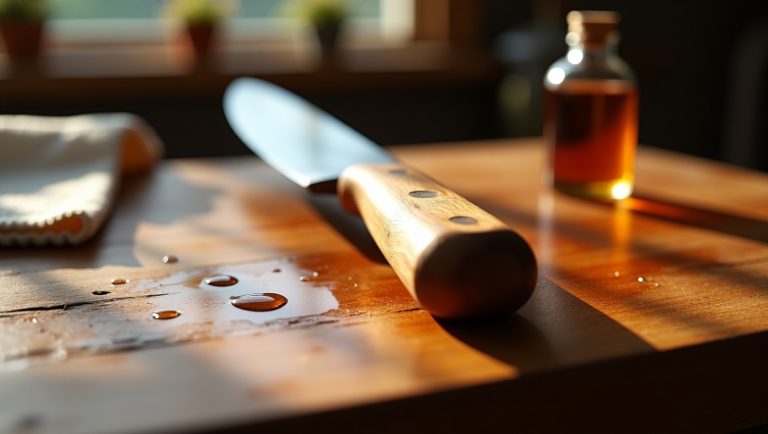Can You Over Sharpen a Knife? Here’s What Experts Say
Yes, you can over-sharpen a knife, which removes too much metal and thins the blade’s edge. This makes it fragile and prone to chips or nicks.
Over-sharpening shortens your knife’s lifespan, reduces cutting precision, and can create uneven edges that cut less efficiently.
Maintaining a consistent sharpening angle and controlled pressure helps prevent this damage. If you want to guarantee your blade stays sharp and durable, understanding proper sharpening techniques is essential.
Key Takeaways
- Yes, over-sharpening removes excessive metal, thinning the blade and increasing the risk of chips, nicks, and micro-chipping.
- Over-sharpening shortens blade lifespan by compromising durability and altering edge geometry, leading to uneven and inconsistent cuts.
- Incorrect angles and uneven pressure during sharpening cause premature dulling, weak spots, and blade damage.
- Signs of over-sharpening include fragile edges, uneven bevels, increased cutting force, and visible blade thinning or warping.
- Proper technique, consistent angles, controlled pressure, and limited sharpening frequency prevent over-sharpening and maintain blade health.
Understanding the Effects of Over-Sharpening on Knife Blades
While sharpening is essential for maintaining a knife’s performance, over-sharpening can severely damage the blade by removing too much metal.
Each sharpening pass eats away at the blade, gradually narrowing its width and shortening its lifespan. Regularly inspecting the blade’s edge can help prevent excessive material removal.
Every sharpening session removes metal, slowly reducing blade width and overall longevity.
Excessive material removal alters the blade’s geometry, weakening its original design and requiring difficult re-profiling.
Over-sharpening also thins critical edge areas, making the blade prone to chips, nicks, and faster dulling.
When you sharpen too aggressively or unevenly, the edge becomes irregular, reducing cutting precision and increasing effort during use. This can also shorten the overall lifespan of the knife significantly.
This fragile edge not only dulls faster but also raises the risk of accidents. Prioritizing safety precautions during sharpening and testing is essential to avoid injury.
To preserve your knife’s durability and cutting quality, focus on minimal, controlled sharpening combined with regular honing rather than frequent, intensive grinding.
Common Mistakes That Lead to Over-Sharpening
You really risk over-sharpening your knife if you don’t keep a consistent sharpening angle. When the angle varies, it can lead to uneven edges and, unfortunately, unnecessary metal removal. Think about it this way: if your angle shifts, you’re not just reshaping the blade; you’re also risking its overall integrity.
Now, let’s talk about pressure. If you apply uneven pressure while sharpening, you might end up creating weak spots on the blade. That’s not good! It can also accelerate the wear and tear of your knife. So, try to keep your strokes steady and controlled—it’s all about finding that rhythm. Remember to maintain angle consistently to avoid uneven edges and ensure effective sharpening.
Oh, and here’s another tip: avoid excessive sharpening passes. It can be tempting to rush or repeat strokes too often, but doing so will thin out your blade and ultimately reduce its lifespan. Additionally, improper maintenance can expose the blade to moisture and lead to rust formation, further compromising the knife’s durability.
Incorrect Sharpening Angles
Because maintaining the correct sharpening angle is essential, using an improper angle can quickly degrade your knife’s edge and lead to over-sharpening. If you sharpen at an angle narrower or wider than the original grind, you’ll remove excessive metal, thinning and weakening the blade prematurely.
It is important to remember that the sharpening angle is the angle formed between the blade and the sharpening tool during honing or sharpening. Different knives require specific angles depending on their steel composition and intended use.
Sudden angle shifts force large material removal, creating burrs and dullness. Consistent, gradual angle adjustments preserve edge integrity.
Many sharpening guides mislead by measuring from the blade centerline rather than the bevel, so relying on them without adjustment risks inaccurate angles that accelerate wear.
Be mindful not to over-angle during strokes, as this destroys the apex and wastes blade material. Use reliable angle guides or fixed-angle sharpeners to maintain precision and extend your knife’s lifespan.
Uneven Pressure Application
If uneven pressure creeps into your sharpening routine, it can quickly undermine the blade’s geometry by creating asymmetrical bevels.
When one side sharpens deeper, you end up with inconsistent edge thickness that disrupts cutting precision and causes the knife to drift during use.
This imbalance also accelerates wear on the thinner side, leading to premature dulling or chipping. Unequal pressure often stems from freehand sharpening, where pushing and pulling apply different forces.
To prevent this, maintain consistent hand positioning and use measured, even strokes on both sides. Using a two-handed Japanese stroke improves consistency in bevel angles, helping to maintain a more symmetrical edge improving sharpening technique.
Marking the blade to monitor material removal helps you adjust pressure strategically. Additionally, honing with a consistent angle preserves the blade’s edge and prevents uneven wear.
Avoid rushing; deliberate, balanced pressure preserves edge integrity and extends your knife’s sharpness and lifespan.
Excessive Sharpening Passes
While sharpening is essential to maintain a knife’s edge, going overboard with excessive sharpening passes can quickly degrade its performance and lifespan. Each pass removes metal, thinning the blade and weakening its structure. It is important to note that factory edges are often less sharp and durable than those crafted by skilled sharpeners, which means sharpening should be done judiciously to avoid unnecessary metal removal.
Over-sharpening alters edge geometry, reducing cutting precision and increasing chipping risk. Frequent unnecessary passes accelerate wear and imbalance. Maintaining proper sharpening angles during each pass helps prevent damage and preserves the blade’s integrity.
| Mistake | Consequence | Solution |
|---|---|---|
| Excessive passes | Blade thinning, edge loss | Limit sharpening frequency |
| Aggressive strokes | Uneven edge, faster wear | Use controlled pressure |
| Ignoring angle control | Poor cutting performance | Maintain consistent angles |
| Sharpening impulsively | Cumulative blade damage | Sharpen only when needed |
How Over-Sharpening Impacts Knife Performance?
Though sharpening is essential for maintaining a knife’s edge, over-sharpening can seriously degrade its performance by altering edge geometry and removing too much material.
When you sharpen excessively, you risk creating a fragile wire edge that bends or breaks easily, reducing cutting precision and sharpness retention.
Over-sharpening also rounds the edge, causing the blade to drag rather than slice cleanly, which demands more effort and decreases efficiency. This can lead to uneven cooking due to inconsistent cuts and blade performance.
Additionally, too much material removal shortens the blade’s lifespan, thinning it and increasing susceptibility to chips and nicks.
Regular sharpening and proper technique are crucial to extend knife lifespan and maintain optimal performance.
Uneven edges from over-sharpening lead to inconsistent cuts and unpredictable blade behavior, compromising your control and the quality of delicate tasks like filleting.
Techniques That Influence the Risk of Over-Sharpening
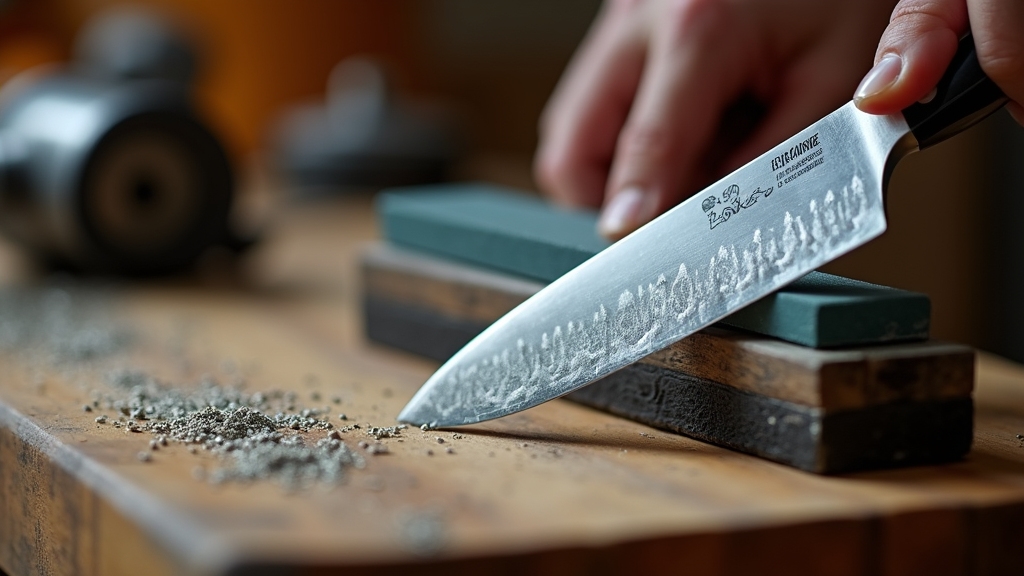
When sharpening your blade, it’s crucial to keep a consistent angle. This helps you avoid weakening the blade or taking off too much metal.
Plus, if you’re careful with the pressure you apply, you’ll likely end up with a nice, even edge. Paying attention to the presence of a knife bolster can also influence how you sharpen, since it may restrict access to the blade.
Oh, and here’s a tip: try alternating hands while you’re sharpening. It can really help balance out your technique and improve the overall consistency of the edge.
Remember that maintaining a correct sharpening angle of 15-20° is ideal for most knives to prevent damage and ensure optimal sharpening results.
Angle Consistency Importance
Because maintaining a consistent sharpening angle directly affects your knife’s edge integrity, you must control the angle throughout each pass to prevent uneven wear and premature dulling. Deviations cause one side to wear faster, risking chips and early dulling.
Different knives require tailored sharpening angles for best results, affecting cutting ability, durability, and overall knife efficiency, so understanding these nuances helps avoid over-sharpening. Many rolling knife sharpeners offer multiple sharpening angles to accommodate these specific needs, ensuring precision.
Sticking to the manufacturer’s recommended angle preserves steel properties and durability. Sharpening at steeper angles removes excessive metal, accelerating over-sharpening, while inconsistent angles thin the blade unnecessarily.
To maintain angle consistency, use angle guides or sharpening jigs, rely on muscle memory with steady wrist positioning, and employ visual aids like the Sharpie method to monitor even material removal. Utilizing angle guides ensures you sharpen at the correct angle for your specific knife type, which is crucial for maintaining edge quality.
Consistent angle control guarantees uniform edge geometry, maximizes cutting performance, and extends your knife’s lifespan by preventing needless metal loss. Proper maintenance of sharpening tools, including cleaning and inspection, also supports consistent sharpening results.
Pressure Control Techniques
When sharpening your knife, controlling the pressure you apply is essential to avoid removing too much metal and prematurely dulling the blade. Excessive force accelerates wear and risks uneven edges.
Use these pressure control techniques to sharpen effectively:
- Modulate Pressure by Stroke: Apply lighter pressure on the leading edge stroke and firmer on the trailing stroke. Start with moderate pressure on coarse stones, then reduce it on finer grits for refinement. Keep in mind that heavy pressure (1500-2000 grams) is suitable only for bulk material removal, not for finishing.
- Distribute Pressure Evenly: Maintain smooth, uniform blade contact with the stone to prevent localized wear and weak points. This technique helps preserve the knife edge geometry and extends the blade’s lifespan.
- Use Sensory Feedback: Regularly check for burr formation by touch or sight, adjusting pressure accordingly to avoid over-sharpening and maintain edge geometry.
Hand Alternation Benefits
Although maintaining a steady sharpening angle is essential, alternating your hands during sharpening offers distinct advantages in controlling pressure and preserving edge geometry.
Switching hands distributes effort, reducing fatigue that causes inconsistent strokes or excessive material removal. This alternation promotes symmetrical edge wear, preventing premature blade degradation and over-sharpening. Holding the sharpener securely on a flat surface can further enhance control during this process.
You should also alternate sides of the blade regularly, balancing stroke count and burr removal for ideal edge refinement. Using the wrist locking technique helps maintain a consistent angle regardless of which hand is in use, enhancing the effectiveness of this alternation.
| Benefit | Effect | Result |
|---|---|---|
| Pressure distribution | Reduces fatigue | Consistent sharpening |
| Side alternation | Balances material removal | Symmetrical edge |
| Burr management | Removes burr evenly | Maintains edge acuity |
Choosing the Right Materials and Tools for Sharpening

Selecting the right materials and tools dramatically influences the effectiveness and longevity of your knife sharpening process. You need to match the stone type and grit to your knife’s condition and sharpening goals.
- Choose the stone material: Water stones cut fast and self-renew but need soaking. Oil stones offer durability and steady sharpening. Diamond stones provide speed and durability, ideal for hard steels. Ceramic stones allow precise work. Arkansas stones excel at fine finishing. Additionally, natural stones like novaculite and Belgian Coticule provide a unique grinding sensation but may have limited availability.
- Select appropriate grit: Use coarse grits (120-400) for damage repair. Medium grits (800-1500) are for general sharpening. Fine grits (3000+) are for polishing and honing.
- Use the right lubricant: Water suits water stones for fast cutting. Oil slows wear on oil and Arkansas stones. Diamond stones often work dry, simplifying cleanup.
Identifying and Correcting Issues From Over-Sharpened Knives
Choosing the right sharpening materials and maintaining consistent angles help protect your knife, but even with care, over-sharpening can happen.
You’ll notice signs like excessive edge thinning, micro-chips, or uneven bevels that reduce cutting performance.
Signs of over-sharpening include edge thinning, micro-chips, and uneven bevels that impair cutting quality.
If your knife cuts unevenly or requires more force despite appearing sharp, over-sharpening is likely the culprit. Regular visual checks can help identify damage such as chips or nicks that indicate over-sharpening.
To correct this, start with a coarser abrasive to remove chips and reshape the edge.
Re-establish a consistent sharpening angle, usually 15°–20°, then polish with finer grits to restore smoothness without further thinning.
If the blade is warped or too thin, consider professional straightening or edge resetting.
Frequently Asked Questions
How Often Should I Sharpen My Knife to Avoid Over-Sharpening?
You should sharpen your knife every 2 to 4 months, depending on how often you use it and the tasks you perform.
Hone regularly to maintain the edge and delay sharpening.
Avoid sharpening on a fixed schedule; instead, sharpen only when you notice your knife losing cutting efficiency.
This approach prevents unnecessary metal removal and extends your blade’s life while ensuring it stays sharp and effective.
Can Over-Sharpening Damage Specific Types of Knife Steel More?
Think of knife steels as personalities—some are tough but brittle, others soft yet forgiving.
Yes, over-sharpening damages specific steels more. Hard steels chip easily under wrong angles, while softer steels dull but tolerate frequent sharpening.
High-carbon blades need gentle care to avoid micro-chips, and fine-grained steels risk uneven edges.
You should adjust your sharpening technique to your knife’s steel type, using correct angles and pressure for lasting sharpness.
Are There Signs of Over-Sharpening I Can Detect Without Magnification?
Yes, you can detect over-sharpening without magnification.
Run your finger carefully along the edge to feel for nicks or unevenness.
Use the thumbnail test by dragging the blade lightly across your nail to sense rough spots or inconsistency.
Also, try cutting thin paper; ragged or uneven cuts signal damage.
Visually inspect the edge under strong light for unnatural reflections or excessive polish, which often indicate over-sharpening.
Does Honing Replace the Need for Frequent Sharpening?
Honing maintains, sharpening restores, and neglect ruins.
You can’t skip sharpening by honing alone because honing just realigns your blade’s edge without removing metal.
Regular honing keeps your knife sharp longer, reduces wear, and prevents slips.
But when your knife struggles to slice cleanly or shows damage, it’s time to sharpen.
Use honing daily for upkeep, sharpening periodically for renewal, and balance both to keep your knives performing at their best.
Can Professional Sharpening Services Cause Over-Sharpening?
Yes, professional sharpening services can cause over-sharpening if they’re not careful.
If they remove too much metal, use aggressive abrasives, or fail to maintain the correct edge angle, your blade can become thin, brittle, and prone to chipping.
To avoid this, choose experienced sharpeners who assess your knife first and use proper techniques.
This ensures your blade stays sharp without sacrificing its lifespan or cutting performance.
Final Edge: Can You Over Sharpen a Knife? Only If You Ignore These Tips
Think of your knife like a fine sculpture. Too much chipping away, and its form weakens.
Over-sharpening is that relentless sculptor, stripping away strength and balance with every stroke.
You want a blade that cuts cleanly and lasts, not one worn thin and fragile.
So, sharpen wisely, use the right tools, and stop before you strip away its edge.
Master this balance, and your knife will serve you sharp and strong for years to come.

